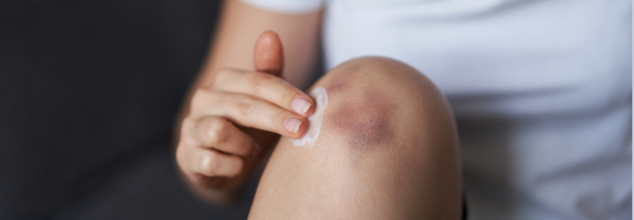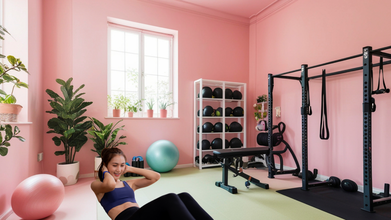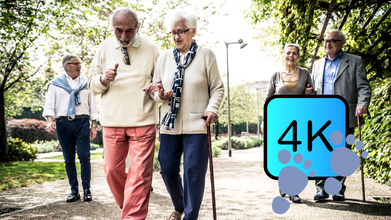- Health Conditions A-Z
- Health & Wellness
- Nutrition
- Fitness
- Health News
- Ayurveda
- Videos
- Medicine A-Z
- Parenting
- Web Stories
Random Bruising After Workout? Your Body Has 1 Of These 5 Things

Image Credit: Canva
Have you ever finished an intense workout, only to find bruises on your body that you never expected? Minor bruising after strenuous physical activity is normal but it may also be a sign of underlying health conditions that should not be ignored.
This condition of bruising happens because the blood vessels are damaged under the skin, and that is why it causes bruising and pain. Although this may not cause any concern on one or two occasions, recurrent or unidentified bruises may be the warning sign that your body sends to you to alert you of something being wrong.
In this article, we will discuss why bruising occurs, medical conditions that could be causing it, and when to see a doctor.
How Do Bruises Form on Your Body?
Bruises are formed when small blood vessels break and leak blood under the skin, which causes a red, purple or black-and-blue mark. Most bruises are subcutaneous, meaning they occur just beneath the skin, but some can occur within muscles or bones, according to the American Academy of Orthopaedic Surgeons.
The severity of a bruise depends on the force of impact and the condition of the blood vessels. Mild bruises may fade in a few days, but more severe bruises can take weeks to heal.
Common Causes of Exercise-Related Bruising
1. Prolonged or Intense Exercise
If your workout involves prolonged strain—such as long-distance running, high-intensity weightlifting, or endurance training—your muscles and blood vessels can become weakened, making bruising more likely.
2. Accidental Impact
Many get bumped into gym equipment, weight racks or even barbells while exercising. The constant pressing weight from doing exercises like deadlifts or squats may even cause bruises at times, normally around the legs and arms.
3. Aging and Skin Thinning
As we age, our skin and blood vessels naturally become thinner and more fragile. According to the Mayo Clinic, aging reduces collagen production, making bruising more common especially in individuals over 50.
4. Medications That Affect Blood Clotting
Some medications can cause your skin to bruise easily, such as blood thinners like aspirin, anticoagulants and even some over-the-counter pain relievers. If you notice frequent bruising, consult your doctor about possible medication side effects.
5. Underlying Health Conditions
Persistent bruising could be a sign of an underlying medical condition. Vitamin deficiencies, blood disorders and even kidney or liver diseases can affect the body's ability to heal and clot properly.
5 Medical Conditions That May Be Causing Your Workout Bruises
1. Vitamin C Deficiency (Scurvy)
Vitamin C plays a crucial role in collagen production, which helps strengthen blood vessels. A deficiency can lead to weakened capillaries, causing frequent bruising, slow wound healing and fatigue.
2. Hemophilia
Hemophilia is a genetic disorder that impairs blood clotting, leading to excessive bleeding and easy bruising even with minor impacts. If you have a family history of hemophilia and experience frequent bruising, it’s best to seek medical advice.
3. Leukemia
Leukemia, a type of blood cancer, can cause unexplained bruising due to a low platelet count. If bruising is accompanied by fatigue, fever or unexplained weight loss, consult a doctor immediately.
4. Vitamin K Deficiency
Vitamin K is a vital nutrient for the proper clotting of blood. A deficiency leads to easy bruising and excessive bleeding. Low levels of vitamin K can occur in patients with liver disease, malabsorption disorders or those on certain medications.
5. Kidney or Liver Disease
Both kidney and liver diseases can affect blood clotting mechanisms, increasing the risk of bruising. Chronic conditions such as cirrhosis or renal failure may interfere with clotting factor production, making bruising more common.
How to Reduce and Prevent Bruising after Exercise
If you’re experiencing frequent bruising from workouts, consider the following strategies to prevent and minimize it:
1. Warm Up and Cool Down
Warming up before exercise increases blood circulation, gradually preparing muscles and blood vessels for physical exertion. Cooling down after a workout helps prevent sudden changes in blood flow, reducing the risk of bruising.
2. Maintain a Balanced Diet
Maintaining a diet rich in essential vitamins and minerals, especially vitamin C, vitamin K and iron, keeps your blood vessels healthy and resilient. Leafy greens, citrus fruits and lean proteins are some of the best choices for promoting vascular health.
3. Hydrate
Dehydration is said to cause muscle fatigue and cramping, and this leads to chances of injury and bruising. Ensure you drink enough water before, during and after working out.
4. Use appropriate workout gear
Using protective clothing such as compression leggings or padded gloves, can absorb impact and reduce the likelihood of bruising. If your workout involves heavy lifting, consider adding knee sleeves or shin guards to your protection.
5. Train with a Trainer
A certified personal trainer can help assess your form and technique to ensure that you're not putting unnecessary strain on your body. Poor posture and incorrect lifting techniques can contribute to excessive pressure on muscles and blood vessels, increasing the risk of bruising.
When to Seek Medical Attention
While occasional bruising is normal, you should see a doctor if you experience:
- Large or unexplained bruises that appear frequently
- Bruising that doesn’t heal within two weeks
- Bruises accompanied by excessive bleeding, nosebleeds or gum bleeding
- Fatigue, dizziness, or other unusual symptoms alongside bruising
Did President Trump Have A Stroke? His Walk Suggests So, Says A 'Physical Therapist' As He Explains How Someone's Gait Can Reveal A Lot

Credits: AFP and Instagram
"He walks like this because he's had a stroke and his spatial awareness, balance, strength and gait have all been affected," says a person who claims to be a 'Physical Therapist at a home healthcare, and claims to have a doctorate in his field with 14 years of experience. The video is posted on his Instagram channel @epistemiccrisis with 74.2k followers.
What Are His Claim About President Trump's Stroke?
He claims that the reason why President Trump is Did President Trump Have A Stroke? This 'Physical Therapist' Explains Why He Believes Soall across the red carpet in a video that plays in the background is because "he lacks the spatial awareness to stay on target or on the path in a straight line".
He further says, "This is because I believe he's had a stroke that's affected the left side of his brain and caused weakness on the right side of his body. When one side of your body is weaker than the other, it can become difficult to walk in a straight line anyone. But aside from the physical weakness, your balance is affected as well."
In fact, a 2021 study published in journal Healthcare notes that stroke is a major cause of disability worldwide and balance impairments are common disabling factors in patients with stroke, which could lead to falls.
However, as per the official medical records of the president, no such strokes were mentioned. His medical report pronounced him in "excellent health". The examination was done at Walter Reed National Military Medical Center. The report also emphasized that Trump maintains a "demanding daily schedule without restriction". Not only that, the report has gone so far to declare Trump's cardiac age as 14 years younger than his actual age after an electrocardiogram.
Read More: What Does Trump's Latest Health Checkup Reveal About Him?
Though the 'Physical Therapist' believes otherwise. He says that when he went back to Walter Reed for his checkup, it was a six-week follow-up for a stroke event that "he probably had over Labor Day". "A stroke on the left side of the brain would also explain why he talks nonsense so much more often nowadays and also why when he is fatigued after long travel like you see in that video, his speech is much slower, much quieter and much more slurred," he claims.
The 'Physical Therapist' further claims that being 80-years old, Trump is also experiencing age-related cognitive decline.
Read: Why Is This Doctor Asking President Trump To Take Alzheimer's Test?
Have Their Been Other Claims On President Trump's Health?
Previously, Dr Narinder Kapur, a consultant neuropsychologist and visiting professor at the University College London said that president's behavior over the last six months has been "quite odd and strange," as reported by Express, UK. He said that there may be a possibility of frontotemporal dementia, that the President must take a test for.
There were also claims about President's 'riddled with arthritis' condition and the need for a double hip replacement surgery. Furthermore, Kai Trump, president's granddaughter's latest Instagram post have also raised questions abut his health, especially the hand bruise.
This is not the first time the 'Physical Therapist' from the account @epsitemiccrisis has made a claim about president Trump. In the past, he linked president's use of smaller stairs to climb to the aircraft with having a stroke. He said that he is using smaller sets of stair so "the public won't notice that he's had a stroke". He explains that when someone's had a stroke, it can involve paralysis of the perineal nerve. This bends your foot up towards your head during your walking. If this nerve is paralyzed, you get a "foot drop". He also claimed that the same thing happened with Joe Biden as he also changed with smaller sets of stairs.
However, none of his claims have been attributed, and the White House does medical reports do not corroborated any of such news.
Note: This piece is based on the claims made by the account @epistemiccrisis. Health And Me does not authenticate any of these claims.
What Home Gym Tools Can Help You Stay Fit Without Hitting The Gym?

Credits: Canva
We all know working out had great benefits, but do you also sometimes feel too lazy to go to the gym? Well, you can now work out at your home. For many, the idea of hitting the gym, or waiting for your turn to use the machine, or just dealing with crowd in general could derail the motivation. But, the good news is that there are tools you can buy and set your own home gym.
Bollywood actor Kareena Kapoor Khan's fitness trainer Mahesh Ghanekar also swears by such high-impact equipment. We have shortlisted 8 must have home gym tools from his list that you must have!
Dumbbells
This is a classic one, but is of course a classic strength builder. If there’s one piece of equipment that should top your list, it’s a good pair of dumbbells. Ghanekar recommends a range from 2.5 kg to 20 kg, depending on your level.
Dumbbells help target every major muscle group, from shoulders to glutes, and can be used for both toning and compound movements like squats and presses. Studies also show that free-weight exercises with dumbbells improve muscle coordination and strength more effectively than machines.
Kettlebell
Another classic, and it helps with both strength and endurance. It is compact, but the impact is powerful. They are a great equipment for dynamic movements like swings, snatches, and squats. Ghanekar suggests that you can start with a 5 to 12 kg kettlebell for home use.
Resistance Bands
While they seem easy, they are the best equipment for portable gym. They are most versatile and space-saving workout tools. You can use them for strength training, stretching, or even rehabilitation.
According to Ghanekar, they’re perfect for beginners and advanced exercisers alike because they engage stabilizing muscles and improve flexibility, all without putting too much strain on joints.
Jump Rope
The best way to do cardio at home is by jumping rope. A jump rope is one of the best cardio tools you can own. It enhances coordination, burns calories fast, and boosts cardiovascular health.
Just ten minutes of skipping can match the benefits of a 30-minute jog, says Ghanekar. It’s small, portable, and easy to store, making it an ideal home essential.
Adjustable Bench
An adjustable bench allows you to perform a variety of exercises like presses, step-ups, or core work.
Ghanekar says that the incline and decline positions help activate different muscle areas, especially the chest and arms, allowing a more rounded strength routine at home.
Yoga Mat
A yoga mat is more than just for yoga. It’s a must-have for stretching, pilates, or even bodyweight exercises.
Ghanekar recommends investing in a thick, non-slip mat to improve posture, prevent injuries, and create a dedicated space for mindfulness and recovery.
Foam Roller
Post-workout recovery is as important as training. A foam roller helps release tight muscles, improve circulation, and prevent soreness.
Ghanekar says regular foam rolling can enhance flexibility and speed up recovery, allowing you to stay consistent with your workouts.
Stepper
A simple stepper or aerobic platform is a great way to tone your legs, improve balance, and get your heart pumping.
Ghanekar highlights that stepping workouts improve lower-body endurance and cardiovascular fitness, and can even reduce body fat when done consistently.
Seniors, Pay Attention! Walking Just 4,000 Steps Once a Week Can Significantly Lower Your Risk of Early Death

Credits: Canva
Walking has a lot of benefits, we already know that. However, how much should one walk? a recent study among older people revealed that if seniors could achieve a 4,000 steps goal in one to two days in a week, they would lower their risk of early deaths by a quarter.
This study was led by Harvard University, and published in the British Journal of Sports Medicine.
What Did the Study Find About Older People's Health And Walking?
We all know that staying active brings great health benefits. In fact, Health and Me also covered how walking and staying active could lower the risk of dementia. Until now, however, it was unclear how much should one walk.
With this recent study, researchers found that achieving 4,000 steps per day on one or two days a week could lower risk of death and lower risk of cardiovascular disease, (CVD), as compared to not reaching this level on any day.
How Was The Study That Analyzed Older People's Walking And Its Impact On Health Conducted?
The study analyzed 13,547 American women, who were over the age of 62, with the average being 72. All of them were given trackers for seven consecutive days, between 2011 and 2015. These people were followed for over a decade. None of them had heart disease or cancer at the beginning of the study.
While they were being monitored in the end of 2024, 1,756 women died and 781 developed heart disease.
The study found that those who clocked up at least 4,000 steps a day on one or two days of the week had 26% lower risk of death from all causes, and a 27% lower risk of dying from heart diseases. This was as compared to those who did not reach this threshold on any day of the week. The study further saw that those who achieved the step count for three days of the week, their lower risk of death from any cause increased by 40%, however for CVD related deaths, it remained at 27%.
Takeaways And Limitations
The researchers said that while the most important take away was that people would now have an amount to walk. However, it is important to note that the study was observational, with no firm conclusion, and was done only on women, and assessed for only one week.
The researchers agreed that there is no "best" way to take your steps. The key is to just ensure that you are getting your steps in. "A greater number of steps, regardless of daily patterns, is associated with better health outcomes." The study saw that on an average, women took 5,615 steps a day.
While there were limitations, but the researchers still added, "An important translational implication of these findings is that since step volume is the important driver of the inverse associations, there is no ‘better’ or ‘best’ pattern to take steps; individuals can undertake [physical activity] in any preferred pattern (eg ‘slow and steady’ v ‘bunched patterns’) for lower mortality and CVD risk, at least among older women. These findings provide additional evidence for considering including step metrics in the next [physical activity] guidelines, and that ‘bunching’ steps is a viable option for health.”
© 2024 Bennett, Coleman & Company Limited

